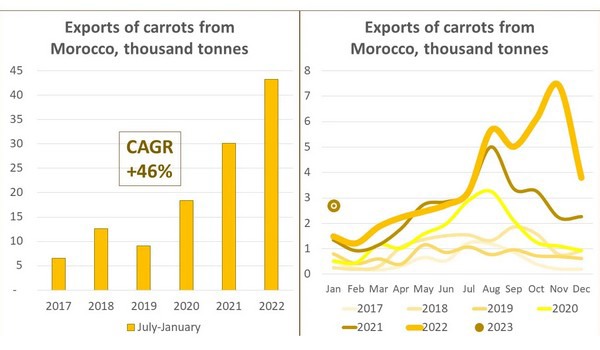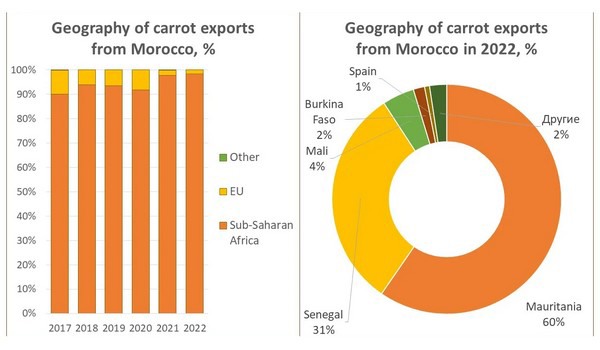The exports of carrots from Morocco continue to grow steadily, and their volume has grown by almost 1.5 times in 2022, as well as in January 2023, EastFruit reports. At the same time, Sub-Saharan Africa remains the key export destination for Moroccan carrots, unlike many other fruit and vegetables.

The exports of carrots from Morocco have increased annually by 46% since 2017 and by 2022 reached a record 43 000 tonnes. Moreover, Moroccan exporters significantly extended their supply season, and the peak shifted to the end of autumn 2022, although exports used to start declining in September. Morocco also started 2023 with a record 2 700 tonnes of carrot exports, up 80% from January last year.
Unlike greenhouse tomatoes or, for example, fresh blueberries, in the supply of carrots, Morocco focuses primarily on the countries of Sub-Saharan Africa, while exports to the EU remain minor and keep declining. Exports to the EU reached their peak of 1 400 tonnes in 2020, but two years later, only 730 tonnes of carrots were exported to the EU from Morocco. It should also be noted that about 10% of all Moroccan carrot exports in 2017 were supplied to the EU countries, and their share had dropped to 2% by 2022.

As for Sub-Saharan Africa, the key importers of carrots from Morocco are the countries of West Africa, or rather the western part of the African Sahel region: Mauritania, Senegal, Mali, Burkina Faso, etc. The Sahel is a rather specific region of Africa with seasonal monsoons causing floods and interсhanging with dry periods. In addition, the Sahel is one of the regions of the world that is most affected by climate change on the planet.
The rainy season in 2021 began with a big delay there, and in some places, there was a serious drought. A year later, the situation in the western Sahel turned to the opposite, and storms swept through the region, causing devastating floods. On top of this, local producers have faced a global increase in fertilizer prices, and the current level of famine threat in the region is very high.
As a result, the countries of the Sahel are forced to increase the imports of many agricultural products, including carrots. For instance, Mauritania at least doubled its imports of carrots and onions over the past five years, with the Netherlands and Belgium being the key suppliers, along with Morocco.
For more information: east-fruit.com
